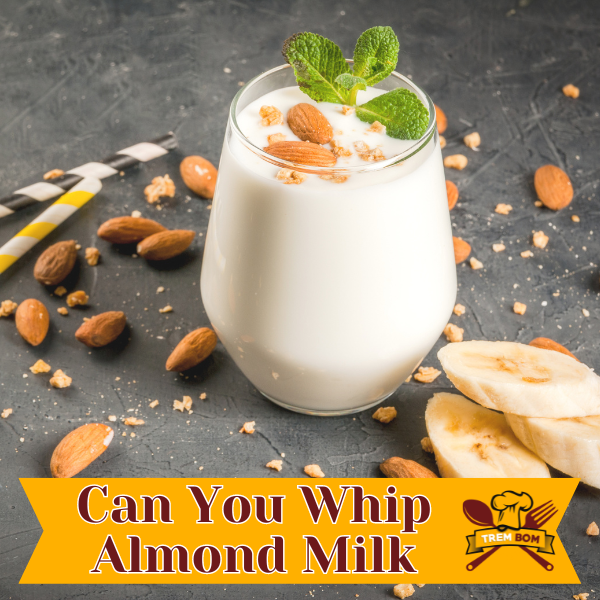
In this article, we will explore the process of whipping almond milk to create a delicious and creamy topping for your desserts. Whether you’re following a dairy-free or vegan diet, whipping almond milk is a great alternative to traditional dairy-based whipped cream.
Key Takeaways:
- Whipping almond milk is possible and provides a dairy-free alternative to traditional whipped cream.
- Choose almond milk brands that have a thicker consistency or are labeled as “creamy” or “barista blend” for better results.
- Chill almond milk in the refrigerator for a few hours before whipping to enhance its ability to hold shape.
- Consider adding sweeteners like powdered sugar or maple syrup, as well as vanilla extract, to enhance the flavor of almond milk whip.
- Use a hand whisk, stand mixer, or electric hand mixer to whip almond milk, starting on low speed and gradually increasing to medium-high until stiff peaks form.
Is Whipping Almond Milk Possible?
Many people wonder if it’s possible to whip almond milk. The answer is yes! While almond milk doesn’t have the same fat content as dairy milk, there are techniques you can use to achieve a light and fluffy texture similar to whipped cream.
One of the reasons why people want to whip almond milk is to create a dairy-free alternative to traditional whipped cream. It allows individuals following a dairy-free or vegan lifestyle to enjoy a creamy topping on their desserts without compromising their dietary choices.
When it comes to whipping almond milk, the process is slightly different from whipping dairy milk. Almond milk doesn’t naturally hold its shape like dairy-based whipped cream, but with the right techniques and ingredients, you can achieve a satisfyingly whipped texture.
“Whipping almond milk gives us the opportunity to enjoy a delightful creamy topping while embracing our dietary preferences.”
So, how exactly do you whip almond milk? Let’s explore the process further:
Choosing the Right Almond Milk
To achieve the best results when whipping almond milk, it’s important to choose the right type. Look for brands that have a thicker consistency or are labeled as “creamy” or “barista blend.” These varieties tend to work better for whipping and provide a richer texture.
Chilling is Key
Before whipping almond milk, make sure it is well chilled. Cold almond milk will whip up better and hold its shape. Place the almond milk container in the refrigerator for at least a few hours or overnight to ensure it is properly chilled.
Don’t Forget the Additions
To enhance the flavor of your almond milk whip, consider adding a sweetener such as powdered sugar or maple syrup. These additions not only add a hint of sweetness but also help stabilize the whip. Additionally, a touch of vanilla extract can provide a delightful aroma to your almond milk whip.
Whipping Techniques
There are a few methods you can use to whip almond milk. You can use a hand whisk, a stand mixer, or an electric hand mixer. It’s recommended to start on a low speed and gradually increase it to medium-high until stiff peaks form. Be patient and avoid over-whipping as it may cause the almond milk whip to become grainy.
Stabilizing the Whip
To ensure that your almond milk whip holds its shape for a longer period, you can add a stabilizer. Cream of tartar or cornstarch are commonly used to stabilize whipped almond milk. These ingredients help maintain the structure and prevent it from deflating.
With these techniques and a bit of practice, you can successfully whip almond milk into a creamy and satisfying topping for your desserts.
| Pros | Cons |
|---|---|
| Delicious and creamy dairy-free alternative | Doesn’t hold its shape as well as dairy-based whipped cream |
| Perfect for individuals following a dairy-free or vegan lifestyle | Requires specific techniques and ingredients for optimal results |
| Customizable with different sweeteners and flavors | May take a few attempts to achieve desired consistency |
Now that you know it’s possible to whip almond milk, why not give it a try? Whip up some almond milk goodness and enjoy a creamy topping that fits your dietary needs.
Choosing the Right Almond Milk
Not all almond milks are created equal when it comes to whipping. To achieve the perfect consistency for your almond milk whip, it’s important to choose the right brand. Look for varieties that have a thicker consistency or are specifically labeled as “creamy” or “barista blend.” These almond milks are specially formulated to have a texture that is ideal for whipping.
Brands such as Silk, Califia Farms, and Almond Breeze offer almond milks that are known for their superior whipping capabilities. These brands have carefully crafted their almond milks to ensure a creamy and smooth texture, making them ideal substitutes for traditional whipped cream.
If you’re unsure which almond milk brand to choose, consider reading online reviews from other users who have successfully whipped almond milk. Their experiences and recommendations can help guide you in making the right decision for your dessert creations.
Chilling is Key
Before whipping almond milk, it is crucial to ensure that it is well chilled. Cold almond milk will whip up better and hold its shape, resulting in a creamy and fluffy consistency.
Here’s how you can chill almond milk:
- Place the almond milk container in the refrigerator for at least a few hours or overnight.
“Cold almond milk will whip up better and hold its shape.”
Chilling the almond milk helps to lower its temperature, allowing the fat molecules to firm up. This makes it easier to incorporate air while whipping, resulting in a light and airy texture similar to traditional whipped cream.
Once the almond milk is chilled, you are ready to move on to the whipping process. But before that, let’s explore the best practices for choosing the right almond milk for whipping in section 5.
Don’t Forget the Additions
To enhance the flavor of your almond milk whip, we recommend adding a few key ingredients. These additions will give your whipped almond milk a delicious taste that rivals traditional dairy-based whipped cream.
Sweeteners
Sweeteners such as powdered sugar or maple syrup can be added to your almond milk whip for a touch of sweetness. These sweeteners not only enhance the flavor but also help to stabilize the whipped texture. You can adjust the amount of sweetener to suit your taste preferences.
Vanilla Extract
Adding a splash of vanilla extract to your almond milk whip can elevate its flavor profile. The subtle vanilla aroma pairs beautifully with various desserts, enhancing the overall taste experience. Be sure to use pure vanilla extract for the best results.
Experiment with different combinations of sweeteners and extracts to create unique flavors that complement your specific desserts. Don’t be afraid to get creative and customize your almond milk whip to suit your preferences.
Now that you know how to enhance the flavor of your almond milk whip, let’s move on to the various techniques you can use to whip almond milk effectively.
Whipping Techniques
When it comes to whipping almond milk, we have a few techniques that can help you achieve the perfect creamy consistency. Whether you prefer a hand whisk, a stand mixer, or an electric hand mixer, each method can yield excellent results. Follow our step-by-step instructions below for a satisfyingly whipped almond milk.
Hand Whisk:
If you don’t have any fancy equipment on hand, a hand whisk can still do the trick. Start by pouring the chilled almond milk into a chilled bowl. Using a hand whisk, vigorously whip the almond milk in a circular motion until it becomes frothy and starts to thicken. This method may take a bit more time and effort, but it can be a rewarding process.
Stand Mixer:
A stand mixer makes whipping almond milk much easier and less time-consuming. Begin by attaching the whisk attachment to the stand mixer. Pour the chilled almond milk into the mixing bowl and start the mixer on a low speed to prevent splashing. Slowly increase the speed to medium-high and continue whipping until stiff peaks form. The stand mixer will give you a more consistent and reliable result.
Electric Hand Mixer:
If you have an electric hand mixer, whipping almond milk becomes even more effortless. Place the chilled almond milk in a bowl and attach the beaters to the electric hand mixer. Start on a low speed to prevent splattering and gradually increase to medium-high. Continue beating until stiff peaks form, and you have a light and fluffy almond milk whip.
Whichever method you choose, it’s essential to start with chilled almond milk and equipment to achieve the best results. Gradually increasing the speed while whipping will help incorporate air into the almond milk, creating a fluffy texture. Remember not to over whip, as it can lead to a grainy consistency.
Stabilizing the Whip
When it comes to whipping almond milk, one challenge is that it doesn’t naturally hold its shape like dairy-based whipped cream. However, there is a simple solution to help the almond milk whip maintain its structure for a longer period: adding a stabilizer.
A stabilizer helps to strengthen the foam and give it stability, ensuring that it holds its shape and doesn’t deflate quickly. There are a few common stabilizers that work well with almond milk, such as cream of tartar and cornstarch.
Cream of Tartar:
Adding a small amount of cream of tartar to your almond milk whip can greatly improve its stability. Cream of tartar is a powdery substance that is commonly used in baking and acts as a stabilizer in whipped cream and meringue.
Cornstarch:
Another option is to use cornstarch as a stabilizer. Cornstarch not only helps to thicken the almond milk but also provides stability to the whipped foam. Just make sure to mix the cornstarch with a small amount of almond milk before adding it to the rest of the mixture.
By adding one of these stabilizers to your almond milk whip, you’ll be able to enjoy the creamy texture for a longer period without worrying about it losing its shape too quickly.
Keep in mind that the amount of stabilizer needed may vary depending on the recipe and desired consistency. It’s always a good idea to start with a small amount and adjust as needed.
| Stabilizer | Benefits |
|---|---|
| Cream of tartar | Improves stability and texture |
| Cornstarch | Thickens and stabilizes the foam |
Tips for Success
Whipping almond milk takes a bit of practice, so don’t get discouraged if it doesn’t turn out perfectly the first time. Be patient and keep the following tips in mind:
- Use a chilled bowl and beaters: Before starting the whipping process, make sure your bowl and beaters are well chilled. This helps to keep the almond milk cold and creates a better whip.
- Whip on high speed: Start whipping the almond milk on low speed and gradually increase to high speed. Whipping on high speed helps to incorporate air into the milk, creating a light and fluffy texture.
- Avoid over-whipping: Keep a close eye on the almond milk as you whip it. Over-whipping can cause the milk to separate or become grainy. Stop whipping once you achieve stiff peaks.
By following these tips, you’ll increase your chances of successfully whipping almond milk into a delicious and creamy topping. Practice makes perfect, so don’t be afraid to experiment and adjust the whipping technique to suit your preferences.
Using Almond Milk Whip
Once you have successfully whipped your almond milk, it can be used as a dairy-free alternative to traditional whipped cream. Serve it on top of desserts like pies, cakes, or hot beverages like hot chocolate or coffee.
Other Variations of Dairy-Free Whips
Almond milk is a popular choice for creating a dairy-free whipped topping, but it’s not the only option available to you. If you’re looking to experiment with different flavors and textures, there are other plant-based milks that can be whipped up into a delightful foam or non-dairy whipped cream. Two alternatives worth considering are coconut milk and soy milk.
Coconut milk: This creamy and rich milk, extracted from the meat of coconuts, can be transformed into a luscious whipped topping. It offers a tropical flavor and a smooth, velvety texture. Keep in mind that coconut milk can have a distinct coconut flavor, so it may not suit every dessert or beverage.
Soy milk: Made from soybeans, soy milk is another great option for creating non-dairy whipped cream. It has a slightly nutty flavor and a lighter texture compared to coconut milk. Soy milk works particularly well in recipes where you want a subtle flavor that won’t overpower other ingredients.
When choosing between these alternatives, consider the flavor profile you desire and the specific recipe you’ll be using it in. Each milk alternative has its own unique characteristics that can enhance different types of desserts and beverages.
Experimenting with different variations of dairy-free whips allows you to create diverse flavors and textures to complement your favorite treats. Whether you’re in the mood for a tropical twist with coconut milk or a lighter option with soy milk, these plant-based milks offer a world of possibilities for your non-dairy whipped cream creations.
Making the Most of Almond Milk Whip
Once you’ve whipped up a batch of delicious almond milk whip, you’ll want to savor every last dollop. To ensure maximum freshness and flavor, it’s important to store any leftover almond milk whip properly.
We recommend transferring the almond milk whip to an airtight container before placing it in the refrigerator. This will help prevent the whip from absorbing any odors or flavors from other foods in the fridge.
When storing almond milk whip, it’s normal for it to lose some of its fluffiness over time. However, don’t worry as it can still be used as a delightful and creamy topping even if it’s not as airy as when freshly whipped.
For best results, consume the almond milk whip within a few days of making it. This will ensure that you enjoy it at its peak flavor and texture. After that, it may start to lose its consistency and become less appealing.
| Storage Tips for Almond Milk Whip |
|---|
| Transfer to an airtight container |
| Refrigerate leftover whip |
| Consume within a few days |
By following these simple storage guidelines, you can make the most of your almond milk whip and enjoy its creamy goodness whenever you desire. Whether it’s a dollop on your morning coffee or a finishing touch on a decadent dessert, almond milk whip is a versatile and delightful addition to your culinary creations.
Conclusion
Whipping almond milk is not only possible but also a fantastic way to enjoy a creamy topping without dairy. By following these tips and techniques, you can create a luscious almond milk whip that will impress your friends and family, whether they follow a dairy-free or vegan lifestyle.
Start by choosing the right almond milk – look for varieties that have a thicker consistency or are labeled as “creamy” or “barista blend.” Remember to chill your almond milk before whipping, as cold milk will whip up better and hold its shape.
Additions like sweeteners such as powdered sugar or maple syrup, as well as vanilla extract, can enhance the flavor of your almond milk whip. Experiment with different whipping techniques, using hand whisks, stand mixers, or electric hand mixers to achieve the desired light and fluffy texture.
While almond milk whip may not naturally hold its shape like dairy-based whipped cream, you can use stabilizers like cream of tartar or cornstarch to help it maintain its structure. Don’t forget to keep a few key tips in mind, such as using a chilled bowl and beaters, whipping on high speed, and avoiding over-whipping.
Once you’ve successfully whipped your almond milk, use it as a delicious and dairy-free alternative to traditional whipped cream. Serve it on top of your favorite desserts or hot beverages for a creamy and satisfying finish. So go ahead and whip up some almond milk goodness for your next dessert!
FAQ
Can you whip almond milk?
Yes, you can whip almond milk! While it doesn’t have the same fat content as dairy milk, there are techniques you can use to achieve a light and fluffy texture similar to whipped cream.
Is whipping almond milk possible?
Yes, it is possible to whip almond milk. By following the right techniques and using chilled almond milk, you can achieve a creamy and delicious whipped topping.
What type of almond milk is best for whipping?
Look for almond milk brands that have a thicker consistency or are labeled as “creamy” or “barista blend.” These varieties tend to work better for whipping.
How should I chill the almond milk before whipping?
It’s important to chill the almond milk before whipping. Simply place the almond milk container in the refrigerator for a few hours or overnight. Cold almond milk will whip up better and hold its shape.
Can I add any flavorings to the whipped almond milk?
Yes! You can enhance the flavor of your almond milk whip by adding sweeteners like powdered sugar or maple syrup. Vanilla extract is another popular addition that gives it a delicious aroma.
What are the different techniques for whipping almond milk?
You have a few options when it comes to whipping almond milk. You can use a hand whisk, a stand mixer, or an electric hand mixer. Start on a low speed and gradually increase to medium-high until stiff peaks form.
How can I stabilize the whipped almond milk?
Almond milk doesn’t naturally hold its shape like dairy-based whipped cream. Adding a stabilizer, such as cream of tartar or cornstarch, can help the almond milk whip maintain its structure for a longer period.
Any tips for successfully whipping almond milk?
Whipping almond milk takes practice. Remember to use a chilled bowl and beaters, whip on high speed, and avoid over-whipping.
How can I use almond milk whip?
Once whipped, almond milk can be used as a dairy-free alternative to traditional whipped cream. Serve it on top of desserts like pies, cakes, or hot beverages like hot chocolate or coffee.
Are there other non-dairy alternatives for whipping?
Absolutely! You can explore other plant-based milks like coconut milk or soy milk. Each milk alternative will yield a slightly different flavor and texture.
How long can I store almond milk whip?
Store any leftover almond milk whip in an airtight container in the refrigerator for up to a few days. It may lose some of its fluffiness over time, but it can still be used as a delicious and creamy topping.





